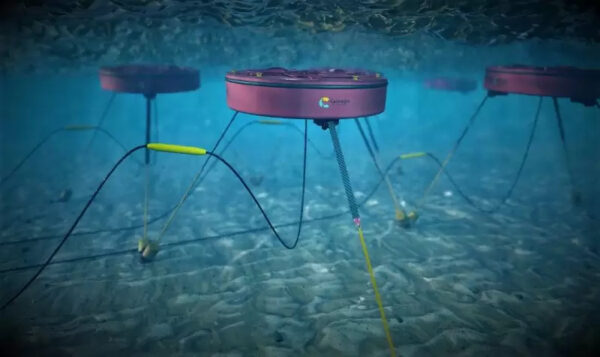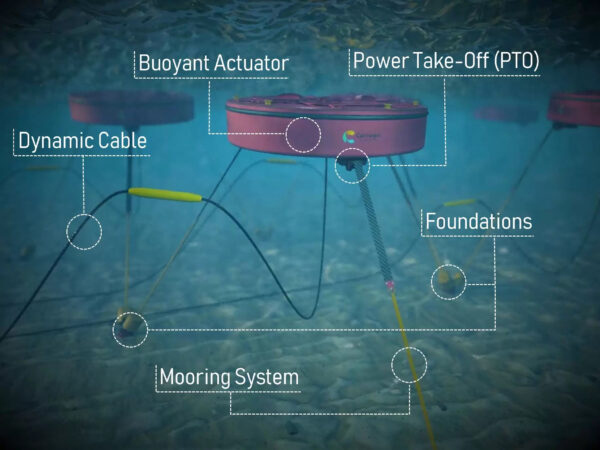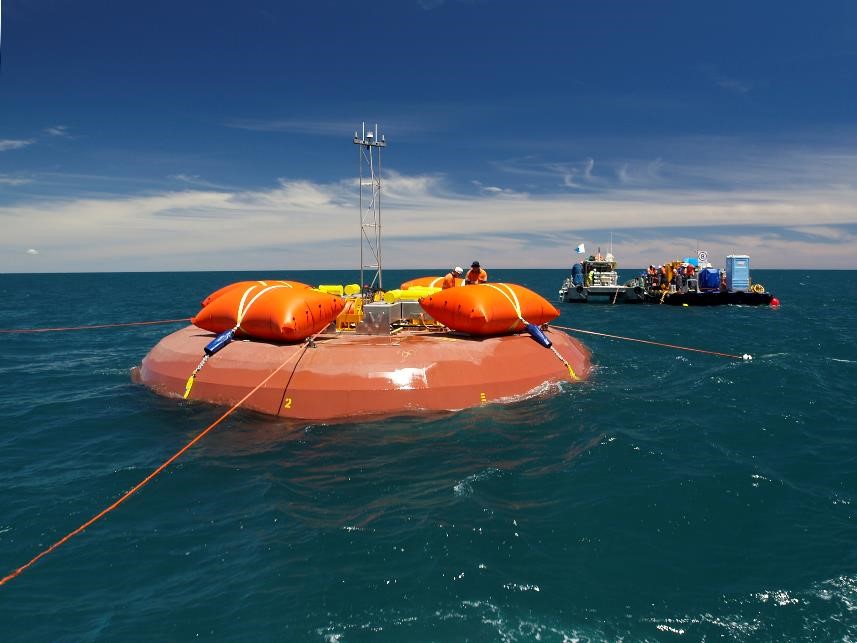Carnegie Clean Energy has beaten an international field of 36 contenders to be awarded $6.3 million in funding to deploy its ‘CETO’ wave power generation technology off the coast of Basque Country, Spain.
Carnegie Clean Energy, based in Fremantle, has had a long and arduous journey to this point. In March 2019, the company was suspended from ASX after missing the results deadline and lost support from the Western Australian government shortly after. Before the month was over, the company was given a funding lifeline but was forced to sell or wind down its solar microgrid subsidiary. (The finances of wave energy companies are notoriously tricky, more on that below).
Carnegie then focused on its so-called CETO wave energy technology, which now comes in units of 1 MW of generation capacity at the commercial scale. Submerged, buoy-like devices are tied to the seabed and produce oscillating motion with the movement of the waves.

Image: Carnegie Clean Energy
Contracts to harness wave energy in Europe have been going on for some years. In December 2021, Carnegie Clean Energy was selected to receive a contract under the EuropeWave Pre-Commercial Procurement (PCP) program via its subsidiary CETO Wave Energy Ireland Limited.
EuropeWave PCP is a stage-gate program designed to advance wave energy converter systems to a point from which they can be developed for commercial exploitation through other national or regional programs and private investment.
As part of this programme, in 2022, CETO Wave Energy Ireland undertook tank testing and delivering a CETO concept design for deployment at the open-water facilities of the Biscay Marine Energy Platform (BiMEP) in the Basque Country and the European Marine Energy Centre (EMEC) in Scotland.
Now, with phase three of the Europe Wave PCP in collaboration between Wave Energy Scotland, and the Basque Energy Agency, EuropeWave has awarded Carnegie $6.3 million (€3,746,531) to deliver and operate an approximately 400 kW version of its CETO wave energy converter off the Spanish coast by 2025.
After this last phase of the Europe Wave PCP programme, each company involved will retain ownership of the intellectual property, the results and any physical models, prototypes or other test pieces produced during the PCP.

The tribulations of wave and ocean energy
The promise of wave energy is neither new nor mastered. In fact, attempts to harness the ocean’s power document all the way back to 1799. Since then, thousands of patents have been filed and as many inventors risen and fallen. Today, there are about 250 companies tenaciously grappling with the problem, Swinburne’s Professor of Fluid Dynamics, Richard Manasseh, previously told pv magazine Australia.
While the mechanisms required to harness energy from the ocean are themselves technically tricky, the real hurdle is our current financial models for commercialising innovation. “The machines don’t work at all unless they are gigantic,” Manasseh says. “So there’s a mismatch between the amount of capital companies tends to have and the size of what they have to build.”
A single wave energy machine can cost anywhere from a few hundred thousand to a few million to build, depending on the design’s sophistication and efficiency.
It’s hardly surprising then that wave energy has stranded many on the shores of financial ruin. The primary reason for that is not because the designs aren’t good enough or the technology unviable. The issue, Professor Manasseh says, is that our current model for commercialising innovations sees governments take a back seat, letting inventors invent and capitalists provide capital.
This pathway doesn’t work for wave energy converters, Manasseh says, because the machines are actually forms of infrastructure, not products. They’re more comparable to highways than wind turbines. “It’s infrastructure that has to be done on a large scale.”
This doesn’t mean the projects have to be paid for by taxpayers, the professor adds, there are many different financial models which could be used – but it does mean that governments need to make the call.
This content is protected by copyright and may not be reused. If you want to cooperate with us and would like to reuse some of our content, please contact: editors@pv-magazine.com.









By submitting this form you agree to pv magazine using your data for the purposes of publishing your comment.
Your personal data will only be disclosed or otherwise transmitted to third parties for the purposes of spam filtering or if this is necessary for technical maintenance of the website. Any other transfer to third parties will not take place unless this is justified on the basis of applicable data protection regulations or if pv magazine is legally obliged to do so.
You may revoke this consent at any time with effect for the future, in which case your personal data will be deleted immediately. Otherwise, your data will be deleted if pv magazine has processed your request or the purpose of data storage is fulfilled.
Further information on data privacy can be found in our Data Protection Policy.